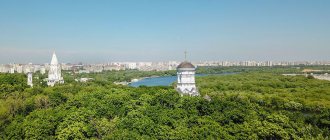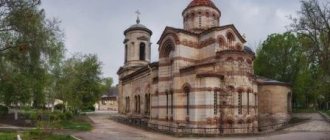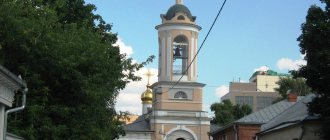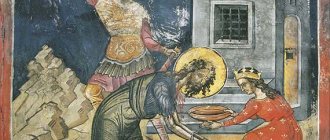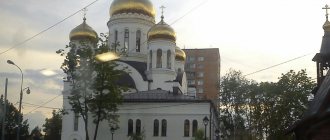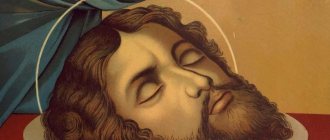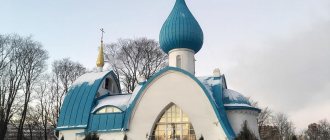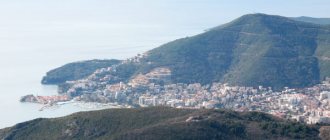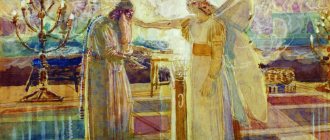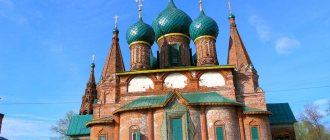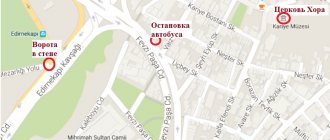The Church of John the Baptist in Tolchkovo is a truly distinctive landmark of Yaroslavl, distinguished by its elegant façade and unique interior paintings. No wonder her image is on the back of the 1000-ruble banknote. However, not every traveler discovers this pearl in the necklace of city temples, and not all local residents have seen this miracle. The fact is that the church is located outside the paths of popular tourist routes, surrounded by industrial buildings. This is an inactive temple, which is the object of the Yaroslavl Museum-Reserve.
The current state of the facade, paintings and nearby buildings causes a bitter feeling and bewilderment - why such a unique church, which was admired by our compatriots and which was idolized by foreigners, was left without due attention. However, recently, work has been carried out to restore the building to its former grandeur and, perhaps, in the coming years it will again appear before tourists in all its splendor.
Panorama of the Church of John the Baptist in Yaroslavl on Google Maps:
History of the construction of the Church of John the Baptist
The 17th century became a heyday for the Yaroslavl lands. Crafts actively developed here. And about a third of all artisans were tanners, that is, they were engaged in tanning leather. Local craftsmen knew how to make yuft (the best leather) of such quality that rich merchants from England and Holland readily purchased it. Therefore, Yaroslavl tanners, as well as shoemakers and furriers, grew rich.
Main entrance to the church
In 1658, a very large fire occurred in Yaroslavl, which destroyed many city buildings. Almost 30 churches, 3 monasteries and about one and a half thousand civilian houses burned down. But after the fire, Yaroslavl quickly recovered, and the townspeople built more and more churches. Residents of Tolchkovskaya Sloboda, located in the city suburb, also wanted to build a new church. Mostly tanners lived here, and the name of the settlement arose from their trade. After all, tanning dye was needed to make leather, and it was obtained by pounding tree bark.
It is believed that previously there were buildings of the Ascension Convent in Tolchkovo, which was destroyed by Polish-Lithuanian troops in 1609. And then there was the wooden Church of the Baptist. Next to it, in memory of the lost monastery, the suburban residents decided to build the winter Ascension Church. But the wooden Church of the Baptist was burned down by another fire. And the residents of Tolchkovo were left without a church at all.
At first, a small Ascension Church made of wood was erected on the ashes and funds began to be collected for the construction of a stone church. Some donated money to the temple, others - silver bars or a trading post, expensive lace or a vegetable garden with buildings. Contributions were accepted in any form, including with working hands. It turned out that the new church was being built “by the whole world.” Thus, the valuable Royal Doors from Kazan and several ancient, richly decorated icons were transferred to the future church.
General view of the church and bell tower from the east
Permission to begin construction and erect two brick factories for these purposes was given by Tsar Alexei Mikhailovich. And the construction itself lasted 16 years. The main reason for this was the need to painstakingly complete a complex architectural design, decoration and painting. And finally, in 1687, two churches - a large summer one in honor of the Beheading of John the Baptist and a small winter one in honor of the Ascension of the Lord were ready.
Story
The location of the temple is the former Tolchkovskaya Sloboda, where leather was produced in the 17th century (to make the leather soft, it was treated with tannin, which was obtained by pounding willow bark). This is where the name “Tolchkovaya Sloboda” came from.
The tanners decided to build a special temple in their settlement, so funds for its construction were collected throughout Yaroslavl and beyond. They helped in whatever way they could - those who had no money brought fabric and lace, those richer donated a vegetable garden or even a factory. So, for example, the Royal Gates were sent from Kazan, decorating one of the chapels of the temple - the Kazan Saints. In addition, many residents provided all possible assistance in the construction of the temple.
A warm temple was erected nearby in honor of the Ascension of the Lord. The entire complex of buildings was built of red brick. The architectural ensemble was created over 17 years from 1671 to 1687, and the painting inside the temple was done at the end of the 17th century.
Throughout the pre-revolutionary period, the authorities paid due attention to the condition of the temple. After renovations that took place in 1903–1906, it looked simply amazing.
The most difficult times began in 1936, when the temple ended up on the territory of Pobeda Rabochy OJSC, which produced varnishes and paints. In the early 50s, the winter church was demolished, and its place was also occupied by a factory.
History of the Church of John the Baptist in the 17th-20th centuries
Almost immediately, an almshouse was set up at the temple, in which 40 old people, disabled people and orphans lived. In the 70s of the 19th century, the church also created a parish trusteeship, and began to issue financial assistance to the poorest parishioners - widowed women and orphans. A little later, a parochial school was opened here, where they taught literacy and numeracy over the course of a year. And at the end of the 19th century, the school was converted into a women's school, and they began to teach there for two years. In addition, a shelter for girls, a sewing and laundry workshop opened their doors. The church even created its own charitable circle, in which 400 illiterate workers of the Yaroslavl Big Manufactory were taught. After the revolution of 1917, this factory began to be called “Red Perekop”.
In the 90s of the 19th century, a temperance society arose at the church, and a separate house with rooms for a library and a tea room was allocated for it. At the same time, they began to publish their own magazine called “Parish Life”, which was published monthly. This was very rare for provincial churches. It is curious that this magazine continued in America. In 1949, the Predtechensky parish was formed there, and 9 years later a church was built using the style of Yaroslavl churches of the 17th century.
View of the western façade
Restoration work was also carried out. So in 1830, the temple painting was partially restored. After 25 years, the iconostasis was gilded, and the dilapidated brick floor was replaced with cast iron.
In the mid-90s of the 19th century, Russian Finance Minister Sergei Yulievich Witte paid a visit to the church, who initiated work on its major restoration. It began in 1903. Specialists replaced the temple foundation, eliminated cracks in the walls, completely restored the frescoes and iconostasis, and also gilded the domes. The floor in the temple was again replaced with tiles. And after 3 years, the Church of St. John the Baptist again appeared in all its splendor.
With the advent of Soviet power, the period of popular love for the church ended. In 1929, the small one-domed Resurrection Winter Church began to be used as a canteen for workers at a paint factory, and in the 50s it was demolished. In 1933, the Church of the Baptist was given to the Yaroslavl Museum. But after 3 years, a grain warehouse, storage facilities for dyes, carbide and acids were placed inside it, and a forge and workshop were also equipped here. The bell tower began to tilt due to the settling of the foundation and work in the forge. And in 1958, extensive restoration work had to be carried out to straighten it. The complete destruction of the temple was prevented after the intervention of Glavnauka.
View of the eastern façade of the church
Yaroslavl Church of the Beheading of John the Baptist in Tolchkovo
The ancient city of Yaroslavl.
You drive along Tolbukhin Avenue to the bridge over the Kotorosl River - and immediately on the right, above the trees, there is a bouquet of marvelous church domes, as if lined up in front of a camera: small ones - lower in front, larger ones - behind them and higher, and the largest one rises, rushing into the sky. As you move along the bridge and change the perspective, the chapters are distributed as if in a row, gracefully completing the massive structure of the temple. We go down from the bridge to the temple and the river. Thrifty drivers also love this descent: they scooped up a bucket of water from the river and washed the car - it’s a wasteland, you won’t be fined, and there’s no one to scold. We make our way through chaotically overgrown poplars, birches, and willows. The brick mass of the temple either disappears or reappears between the greenery. But the thickets are behind you, and in front of you is a marvelous huge temple of intricate architecture, with lacy brickwork on the top and with fabulous fifteen domes. This is the famous Yaroslavl Church of St. John the Baptist. “An outstanding monument of architecture”, “the pinnacle of the Yaroslavl school of architecture of the 17th century”, “the most elaborate Yaroslavl church”, “a monument of world significance”, “a classic creation of the Russian architectural genius”... The most beautiful, the most artistic, the highest, the most - and at the same time, almost forgotten by modern Yaroslavl residents, and Russians in general. They showed no attention to her even when her image as a symbol of “the most Russian” appeared on the 1000-ruble Russian banknote. Ask someone if he knows which temple is depicted on the most popular banknote of the 21st century, only rare scholars and even rarer people who know and love this temple will answer!
This church was included in all pre-revolutionary manuals on Russian architecture, was reproduced in drawings in foreign literature, and its models were presented at foreign exhibitions. Having heard enthusiastic reviews about the temple, Tsarevich Nikolai Alexandrovich († 1865) specially visited it, and Tsarevich Alexander Alexandrovich, the future Emperor Alexander III, having seen the temple only from the outside, asked to send a description of it. The decoration of the church was admired by the Grand Dukes Alexei Alexandrovich, Sergei Maximilianovich, Konstantin Konstantinovich, who visited it twice. Grand Duke Sergei Alexandrovich came here with his wife Elizaveta Fedorovna, now glorified by the Russian Orthodox Church. And how many bishops and statesmen there are! And how she was loved by the people! The remarkable Russian artist Vereshchagin preserved her image in the painting “Porch of the Church of John the Baptist in Tolchkovo” (1888). And even now, in an abandoned state, with paths overgrown with grass, with adjacent ugly factory buildings of a paint and varnish plant, the temple captivates the eye with its grandiose sublimity and uniqueness.
The 17th century for Yaroslavl was a period of its special prosperity. Some associate this prosperity with the ruin of Novgorod and the move of experienced Novgorod merchants, and with them trade, to Yaroslavl, others with the special location of the city. Indeed, trade routes to the White Sea passed through this ancient Volga city - and through it to Europe, to the Caspian Sea - and through it to the Eastern lands. The Yaroslavl princes never competed with Moscow, and therefore, without battle or bloodshed, they joined the Moscow state, remaining faithful to it in all the difficult years and turmoil. And Moscow trade routes went through Yaroslavl, and therefore it played a special role in the Moscow state. More than 800 trading places and 29 foreign offices were concentrated in the city. By the second half of the 17th century, there were 1,175 artisans here. Leather production and related trades – furriery, shoe making and others – were especially prominent. One third of all artisans were engaged in leatherwork. Yaroslavl kofta (the most carefully processed leather) was exported to England, Holland and other European countries. The flourishing of trade and crafts gave the city a special flavor: next to typical Russian buildings there were offices of English and Dutch merchants, shops of Indian merchants with fancy overseas products thinned out the rows of traders of local goods. The city, which had an ancient culture and traditions, absorbed the innovations of both the East and the West with subtle selectivity. And this was most clearly manifested and perpetuated in the temple building of this period. In the monuments of church architecture of Yaroslavl, as in a multifaceted crystal, those features of Eastern and Western art were refracted, which found a response in the national taste of the Russian people. They were embodied in a peculiar transformation of the traditional ancient style, preserving the unique Russian flavor. Oriental tiles and tiled bricks were made with designs and patterns of Russian themes and skillfully complemented purely Russian decor; European baroque was transformed into Russian baroque in graceful arches decorated with carved weaving and was reflected in the design of walls with columns.
The severe fire of 1658 destroyed almost all the ancient temple buildings: 29 temples, 3 monasteries, 1480 civil buildings died in the flames. But the pious and wealthy residents of Yaroslavl restored their city in even greater beauty. Dozens of temples were continuously built: generous contributions made it possible to use the best builders and craftsmen, the best materials; implement complex architectural designs. Sometimes two or three churches were consecrated a year. Merchants were in a hurry to leave a memory of themselves in godly works of architecture, and in this impulse even a certain spirit of competition arose: who is better, who is more generous, who is more original.
It was on this wave that the Church of John the Baptist was created, after such original Yaroslavl pearls as the churches of Elijah the Prophet, the Nativity of Christ, and John Chrysostom.
The temple is located on the banks of the Kotorosl River. Previously, this was a suburb of the city, inhabited mainly by tanners, which was called Tolchkovskaya Sloboda: tanning dye was needed for the tanning industry, obtained by pounding tree bark, hence the name - Tolchkovo.
According to local legends, there was once an Ascension Convent on this site, which was devastated by the Poles in 1609. To this day, no documents remain about this; it is only known that later there was a wooden church in the name of John the Baptist with a chapel to the Kazan Icon of the Mother of God. “You, priest Konon, in that new church in the name of the holy, glorious Prophet and Forerunner and Baptist of the Lord John, would serve for six weeks on all days, and for the chapel you would order another priest to be hired and you would order him to serve the fortress according to the same thing,” - wrote Metropolitan of Rostov Varlaam (Starorushin; † 1652) in 1644 in a letter to the priest Konon. But this small wooden church was not enough for the residents of the settlement, and they asked permission to build a winter church in honor of the Ascension of the Lord, apparently remembering the ruined Ascension Monastery. They received this permission. But before they had time to start building the winter church, the wooden Baptist Church, preserved from the fire of 1658, burned down in 1659: “In the summer from the creation of the world 7167 (1659) in the city of Yaroslavl, the large Tolchkovskaya settlement, the wooden church of St. John the Baptist on the day of Holy Easter, at the service of the Divine Liturgy, by the will of God or the negligence of the church servants, it burned within with a great flame, from which everything burned even to the foundation.”
On the ashes, the Tolchkovo residents rebuilt a small wooden Ascension Church, but they planned to create something grandiose, since the funds of the rich artisans of the settlement made it possible to realize the most daring plan. At the head of the new project were “Priest Abrosim and Deacon Rodion,” who devoted themselves to this wonderful cause for many years. Funds were collected not only from the residents of the settlement, but also far beyond its borders: Deacon Rodion even traveled to Kazan, from where he brought generous offerings. The book on accounting for donations resurrects the touching simplicity of the settlement's donors: some bring an ingot of silver, some lace worth 32 rubles, and some garden land with buildings. They gave away shops and houses, someone gave away a factory, and Kazan donors gave away the royal gates, which for many years decorated the chapel of the Kazan saints. Contributions were accepted in any form; those who could not sacrifice money and things offered their hands to carry out all kinds of work on the grandiose construction project. “The temple of God was built by a merchant’s sum” and labor and diligence, so we can say that this temple is a people’s temple, or, as they said then, “secular.”
With the permission of Tsar Alexei Mikhailovich dated June 29, 1671, two brick factories were specially built on abandoned government lands. In a charter dated August 15, 1671, Metropolitan Jonah (Sysoevich; † 1690) gives permission to build a temple in honor of the feast of the Beheading of John the Baptist with two chapels: one in the name of three saints: Basil the Great, Gregory the Theologian and John Chrysostom; the other - in the name of the Kazan miracle workers Guria and Barsanuphius. This temple took sixteen years to build, but not because of long-term construction, as in Soviet times, but because of the painstaking execution of a complex architectural composition, because of the careful and loving execution of all the details and paintings. The design used patterned bricks, which was typical of the Yaroslavl school of architecture. Freely operating with different configurations of bricks, the builders created amazingly beautiful plastic wall surfaces, where large details are adjacent to smaller, fractional ornaments. Brick walls dotted with tiled inserts “give the impression of an intricate carpet, slightly faded and darkened with time and therefore especially harmonious.”
The temple was a four-pillar, five-domed church with covered one-story galleries on three sides, which was typical for Yaroslavl. The entrance to the galleries was three high gable porches on pillars. The temple had two symmetrical aisles. As a rule, the aisles were made below the main level, but here they were made the same in height as the main cube, which created the impression of a special grandeur of the temple. The unusualness of the temple was also given by the graceful five-domed domes made instead of traditional domes, which were crowned with two ceilings, first used in Yaroslavl architecture. Grandiose in size (its height reached 44 meters), fantastic in the silhouette of its 15 chapters, the Church of John the Baptist dazzled with the luxury of decorative decoration and the skill of its execution. The unknown Tolchkovsky master seemed to strive to incorporate into his creation everything that Russian temple construction of his era was famous for, while maintaining amazing harmony. The cathedral representativeness of the five-domed Moscow churches, the solemn grandeur of the Volga region churches, the multi-domed wooden northern churches, and the decorative multi-colored Yaroslavl temple buildings are brought together into a single whole. The question still arises: according to whose design was this wonderful temple built? There is neither the author of the project nor the construction manager in any documents. Many travelers who admired the Church of the Baptist, especially in the first half of the 18th century, attributed the construction either to Bukhara merchants or to Dutch architects. But in reality, the temple does not have a single detail that is unusual in Russian architecture and decorative design that has not been used before. But here these details are embodied with unprecedented richness and harmony. On the other hand, it is known that the head of the Rostov and Yaroslavl departments at this time (from 1652 to 1690) was Metropolitan Jonah (Sysoevich), who was distinguished by his special love for temple building, had extensive knowledge in this area, and had a special talent as an architect. Under his leadership, many churches and monasteries were built in Rostov, Uglich, Yaroslavl and even the Rostov Kremlin. Many researchers point out that one cannot ignore the possibility of the influence of this remarkable architect-saint on the construction of the Church of John the Baptist, and, possibly, his leadership.
The interior decoration of the temple almost exceeded its external splendor. Sixteen of the best masters under the leadership of Dimitri Grigoriev Plekhanov, a hereditary icon painter, and the young icon painter Feodor Ignatiev were engaged in its painting.
Dimitry Grigoriev was by this time a venerable master: it is known that he had previously taken part in the painting of the Archangel Cathedral of the Moscow Kremlin, the Rostov Assumption Cathedral, the Yaroslavl Church of St. Nicholas the Mokroy, the Rostov Church of the Savior on the Senya. As a contractor and manager, he painted the Assumption Cathedral of the Trinity-Sergius Lavra and the Vologda St. Sophia Cathedral. It is assumed that he will participate in many other churches: in Tutaev (Voskresensky), in Yaroslavl (Demetrius of Thessalonica and Epiphany) and Rostov (Voskresensky, St. John the Evangelist, Trinity Cathedral of the Rostov Yakovlevsky Monastery). There is no doubt that the artists of the Tolchkovo Church also had a very good theological education for that time. This allowed them not only to cover the New and Old Testaments, the history of the Russian Church, the lives of saints, and liturgical subjects in their painting, but also to freely embody these religious and artistic ideas, which required knowledge of many additional nuances. This is a real encyclopedia of gospel and biblical subjects, which has no equal not only in Yaroslavl, but also in all ancient Russian wall iconography. The altar presents a cycle of 18 compositions on the theme “Interpretation of the Liturgy,” one of the most complete in Eastern Christian art. Here are plots of Orthodox holidays and events from the earthly life of Christ. Many of the scenes are of Byzantine origin: “The Great Mirror”, “The lemon garden, that is, the flower garden”, etc. The walls are painted in nine tiers with fragments that are unique in color and subject matter. The five lower tiers were occupied by the calendar (saints), where saints and holidays are depicted sequentially by month and day. The sixth row depicts in detail scenes from the life of John the Baptist: the flight of Elizabeth with the baby John into the mountains, the angel leading John into the desert, John's preaching and his deeds at the court of King Herod. Herod's prophetic dream is depicted: an eagle pecks out his eyes. In terms of the number of subject paintings, of which there are more than 500 in the temple, the temple has no equal in the world.
It is interesting that the temple was painted in just one year - from June 5, 1694 to July 6, 1695. The possibility of carrying out such a grandiose task I.A. Tikhomirov explains by “the integrity of the artistic and religious worldview, which gave the brush that calm confidence that is perhaps the main charm of this infantilely naive art, beautiful and holy, like the prayer of a pure child.” N.N. calls fascinating storytellers. Voronin of these artists, who with the richest visual imagination embodied hundreds of themes and subjects on the walls of the temple. “In the porches where pilgrims rested, painters unfolded before their eyes colorful suites of edifying short stories, instructive and complex allegories, explained with inscriptions and flavored with a sense of folk humor. On the brightly consecrated walls of the temple, images of gospel events, parables, acts of the apostles and church holidays were placed in several tiers. The living optimistic spirit of Yaroslavl artists revived these canonical themes with their warm touch, translating sacred scenes into the language of generally understandable images: the prophet Elisha walked through a golden field of rye among Russian reapers with sickles, Cain plowed the land on a white horse harnessed to a Russian plow, biblical heroes performed in rich Russian clothes." Such details of Russian life seemed to bring distant events closer to modern Russian life, making them more voluminous for the ordinary Russian person.
The icons of the temple were almost of great value, many of which were significantly older than the temple itself, since they were donated by pious Yaroslavl residents. The most famous was the temple icon of the Beheading of John the Baptist. Richly strewn with jewels: pearls, garnets and other precious stones from ancient Greek writing, she was revered as miraculous. The icon of the Ascension of the Lord is wonderful, the “Symbol of Faith” icon is very interesting, and there are many, many other rare icons.
Of particular value were the royal doors of the chapel of the Kazan saints Guria and Barsanuphius. As mentioned above, they were donated by Kazan philanthropists in finished form. Wooden carvings with gilding on a colored background are made in a jewelry manner, reminiscent of the grace of Chinese craftsmen. Tsarevich Nikolai Alexandrovich, who visited the temple in June 1863, especially noted the value of these gates and expressed a desire not to renovate them in order to avoid making any changes to the exquisite pattern.
The ensemble of the Church of St. John the Baptist also included an elegant 45-meter six-tier bell tower, the four upper tiers of which are cut through by bell arches. In some design details, and in the very appearance of the bell tower, a significant influence of the magnificent “Naryshkin” baroque, harmoniously combined with the patterned Yaroslavl architecture, is noticeable. The wide cornice of the third tier, arch openings and decorative turrets, generously decorated with a white stone carpet pattern, harmoniously echoed the architecture and decorative decoration of the temple. Famous architect A.M. Gornostaev wrote about her: “Her exquisite, delicate silhouette is perfectly suited to the majestic cathedral masses of the temple.”
From the very beginning of the existence of the temple, an almshouse was organized near it, which was customary in those days. 40 poor and wretched people found refuge in it. In 1879, at the request of the parishioners, a parish guardianship was opened, the activities of which included the provision of cash benefits to poor parishioners, mainly widows and orphans. Through his efforts, a one-class parochial school was established in 1885. In 1896 the school building was expanded and the school was converted into a two-form girls' school. She opened a shelter for girls, a women's workshop - a seamstress and a laundry. Later, a new two-story house was built, which housed a shelter for 35 girls and a school for 200 students.
V.V. Vereshchagin. The porch of the Church of John the Baptist in Tolchkovo. 1888
In 1891, a women's charitable circle was formed at the church, through whose efforts a literacy school was opened at the Yaroslavl Big Manufactory factory, where 400 girls studied.
On May 17, 1892, a temperance society was formed at the temple, for which a special house was allocated with a reading room, a library and a tea room.
In 1898, under Rector Theodore Uspensky, the publication of the unique monthly magazine “Parish Life” began, perhaps the only magazine of its kind published in the province. It is interesting that a magazine with the same name, and probably with the same tasks, continued its life in distant America, in Washington, under the parish of John the Baptist, founded in 1949 by St. John (Maksimovich, † 1966; commemorated June 19), archbishop Shanghai and San Francisco. The birth of the parish occurred on the feast of the Beheading of John the Baptist. Later, in 1958, a temple was built in honor of this holiday, made in the Yaroslavl style of the 17th century, probably the only one of its kind on the American continent.
The tradition of the Baptist Church in Tolchkovo was to hold processions of the cross, which always inspired and delighted the flock in their unity of serving God. Back in 1667, upon completion of the construction of the warm stone Ascension Church of the Predtechevsky parish, Bishop Jonah (Sysoevich) gave, at the request of the parishioners, a blessed letter for the annual procession of the cross on the parish patronal feast of the Beheading of John the Baptist from the Yaroslavl Assumption Cathedral to the Tolchkovskaya Sloboda. On another patronal feast - the Nativity of John the Baptist - Metropolitan Jonah blessed the Assumption archpriest to “walk from the cross throughout the years, perform a prayer service and bless the water as they go to other churches” in 1672, at the beginning of the construction of the stone Church of John the Baptist. It must be assumed that the annual celebration of two religious processions supported the Predtechevsky parishioners in the work of building churches and provided additional funds for their completion. The religious processions were accompanied by the Tolga Icon of the Mother of God, beloved by the Yaroslavl residents.
Such intense and fruitful work was carried out at this wonderful church.
"Song of Songs". Temple fresco
Before the revolution, the temple, this pearl of Russian architecture, was treated with great attention: in 1830, some frescoes were renewed, and in 1855 the iconostasis was gilded. The brick floor of the temple was replaced with cast iron. In 1894, the temple was visited by the Minister of Finance S.Yu. Witte and noted that the temple requires major repairs. Specialists were seconded from the Imperial Archaeological Commission to determine the location and extent of destruction of the temple. After many minor works to analyze the causes of destruction, restoration of the unique structure began in 1903. An amount of 64,080 rubles was allocated for restoration, which was later increased several times as restoration work expanded. Under the supervision of experienced architects, a complete replacement of the foundation was carried out: the stone cobblestones on which the temple was built were replaced with concrete slabs under the temple and brick slabs around the perimeter, since it was the uneven settlement of the foundation that caused significant cracks. The latter have also been fixed. The wall paintings were washed and restored, and the icons of the entire iconostasis were restored. The cast-iron floor was replaced with tiles, and 15 domes of the temple were gilded. By 1906, the temple was restored in all its ancient splendor.
This ended the period of special popular love for the temple, as if the reserve of veneration allocated to it had been exhausted. For the church, as indeed for almost all of our churches, the time of desecration begins.
After the revolution in November 1929, the winter Church of the Ascension was transferred to the factory canteen, and in the early 1950s it was demolished. In January 1933, the Church of the Baptist was transferred to the jurisdiction of the Yaroslavl Museum. The community of the Baptist Church was abolished in May 1935. In 1936 he included the temple building in his territory. It was used as a warehouse for grain, and the gallery was used for storing bulk dyes, acids, and carbide. The first tier of the bell tower housed a workshop and a forge. True, thanks to the intervention of the Main Science Department, it was possible to stop the barbaric use of the temple as a warehouse.
From September 4 to September 19, 1958, unique work was carried out to straighten the bell tower under the leadership of E.M. Handel. Due to the uneven settlement of the foundation, apparently after its use as a forge, it deviated by more than 1.5 meters, and the tilt continued to increase catastrophically.
Now the church is part of the Yaroslavl Museum-Reserve. On the outer southern wall of the temple there is a board with the inscription: “Architectural monument. Church of John the Baptist. 1671–1687 A unique monument to the Yaroslavl school of architecture during its peak period. The mural was completed in 1694–1695. Yaroslavl masters led by Dmitry Grigoriev and Fyodor Ignatiev. Carved golden iconostasis of 1701 in the Baroque style, in the border of the Kazan Wonderworkers there is a unique carved gate of the mid-17th century.” We will not describe the state of the unique paintings of the temple: this is a sad sight! Looking at the tiles knocked out like eyes, at the bell tower that gave shelter to the trees that grew on its third tier, at the disfigured but once beautiful cast-iron-stone fence, at the islands of garbage from picnics in nature, you involuntarily remember what the piety of our distant ancestors.
However, it can definitely be said that much is not irretrievably lost. The original image of the temple was preserved in many pre-revolutionary photographs, as well as wall paintings depicted in many albums and books. The style of icon painter Dimitry Grigoriev is well known to our modern artists.
The restoration of the gallery was carried out by the All-Union Scientific and Production Plant. Currently, a team of Yaroslavl restoration artists led by Evgeniy Aleksandrovich Chizhov is working on it. But the work clearly requires financial, moral, and possibly scientific support.
In his book about Yaroslavl, published in 1912, Yu. Shamurin says in the preface: “In dreams, Russian people live in the 21st century, but reality imperiously reduces them to the 17th. From this disharmony will be born a distrust of Russian modernity, a general negative view of it... We are accustomed to seeing only funny and sad sides in the historical past of our homeland..." Today, for us, living in the 21st century and knowing what happened later, in 1917, it is time to learn to rejoice reality. And not to be ashamed of our past, but to be grateful to the distant 17th century, to the piety of our ancestors, who left us the ingenuous, captivating beauty of churches - pure, “like a child’s prayer,” filled with deep faith, joyful hope and all-forgiving love.
Architecture and interior decoration of the Church of John the Baptist
The design of the Church of St. John the Baptist is typical for Yaroslavl churches. This is a four-pillar temple with a five-apse altar, surrounded on three sides by one-story covered galleries. The grandeur and majesty of the building is given by the fact that two aisles were built flush with the main volume. There are five large chapters installed on the temple, and each of the side chapels has five small ones.
Unfortunately, the author of the project and the leaders of the construction of this wonderful temple are not known to us.
But the names of those masters who were engaged in interior painting of the church have been preserved. It is known that 16 isographers worked on the frescoes, led by the hereditary icon painter Dmitry Grigorievich Plekhanov and the young master Fyodor Ignatiev. Plekhanov by that time had become famous for his paintings of large churches in Moscow, Rostov the Great, Trinity-Sergius Lavra and Vologda.
Moreover, judging by the quality of the elaboration of the plots, it is clear that the icon painters had an excellent theological education. In the altar part of the temple they made 18 compositions on the topic “Interpretation of the Liturgy.” In total, the church contains more than 500 subject paintings. There is no such voluminous and high-quality mural painting anywhere else in the world.
It is noteworthy that icon painters, in order to make biblical stories more understandable to ordinary people, added many characteristic Russian details - clothing styles and everyday tools that were common in those days. The painting itself took only one year. This indicates the highest qualifications of the craftsmen who worked in the church.
Church bell tower
The external decor of the temple is amazing in its splendor. The three-dimensional patterns decorating its walls are made of tiles and specially made figured (or patterned) bricks. It seems that the temple is “wrapped” in a luxurious Persian carpet. This style, called Russian or Moscow patterning, was formed in the 17th century. It is characterized by the complexity of the composition, intricate forms and abundance of decor.
Next to the church there is a high 45 m bell tower, built at the turn of the 17th-18th centuries. Its two lower tiers are closed, and the four upper ones are open and decorated with intricate carved arcades. The architectural style used in the construction of the bell tower is Moscow Baroque. In the 17th century, it organically replaced the Russian pattern. The bell tower is harmoniously combined with the church because the division into tiers of these two buildings coincides. The temple area is surrounded by a partially preserved fence with the Holy Gates built in the Moscow Baroque style.
Architecture and interior
Unfortunately, it is not known for certain who the author of the project was, but there is an opinion that Metropolitan Jonah (Sysoevich), who had architectural talent, had something to do with it. At that time he was the head of the Rostov and Yaroslavl departments. There was also a version that it was built by foreign specialists. However, if you look closely at the details, you can dismiss this version, because the temple is a striking example of Russian architecture.
The height of the building reaches 44 meters, the church is crowned with 15 chapters - 5 on the main temple and each of the side chapels. An interesting detail is that the aisles are located at the same height as the main building; in most other similar buildings they are lower. The façade of the building is replete with decorative elements, one of the main ones being figured brick. It is distinguished by a variety of forms; on the structure you can see rollers, rosettes, beads, kokoshniks and other variations. This creates a unique carving effect that harmonizes with tiles that have different subjects and ornaments.
Not only the external appearance of the temple is magnificent, but also its interior. The best artists of the Yaroslavl artel worked on its painting. This is truly a historical heritage, because no other temple in the world has such a number and variety of subjects. Here you can see scenes from the Old Testament, Gospel stories, lives of saints and other paintings.
Tiles, © Svetlana Appolonova
Current state of the Church of John the Baptist and visiting hours
St. John the Baptist Church has the status of a historical and cultural monument at the federal level. It belongs to the Yaroslavl Museum-Reserve and is protected by UNESCO.
Today, restoration and research work in the church continues. There are no services held in this temple. You can view it inside from 10.00 to 17.00, except Monday and Tuesday.
North porch of the church
How to get to the Church of John the Baptist
The Church of John the Baptist is located in Yaroslavl on Zakotoroslaya embankment, 69.
It stands not far from the bridge over Korotosl, in the place where Tolbukhin Avenue crosses the river.
By car. From Moscow, the M8 federal highway leads to Yaroslavl. Within the city limits it is called Moskovsky Prospekt. Along it you need to cross the Yaroslavl railway, and, before reaching the Korotosl River, turn left onto Bolshaya Fedorovskaya Street. After driving along it for 1.1 km, turn right onto Tolbukhin Avenue. The church will be visible on the left along the way, before the bridge over the Korotosl River.
By train. Train express trains travel from Moscow to Yaroslavl in 3 hours and 16 minutes. The journey by regular train takes from 4 to 5.5 hours. From Moskovsky Station in Yaroslavl, the distance to the Church of John the Baptist is 1.8 km. You can walk them or take a taxi.
Attraction rating
Rating 4.00 [13 vote(s)]
| ← Yaroslavl region | Yaroslavl | Russia → |
